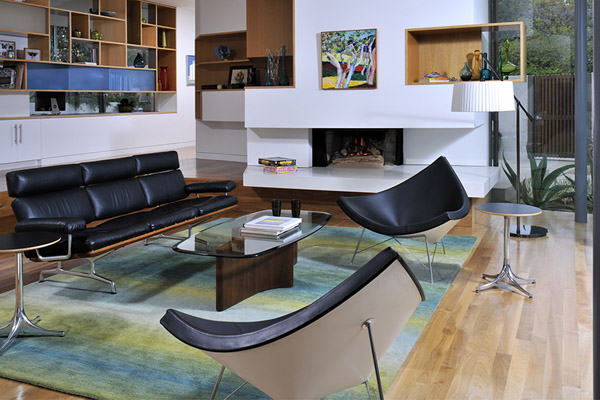The training arm of Design Engine has had relationships of varying degrees with what might be termed the big five of U.S. office furniture. These noted firms, Steelcase, Herman Miller, HNI (All Steel), Haworth and Knoll had some involvement with the 3D training program partially because of their relatively close proximity (HNI located in Iowa and the rest with presence in Western Michigan) to Design Engine’s Chicago office. It was the highly regarded, tailored training program itself that drew in people from the design and engineering staffs from these firms. Key to Design Engine’s approach was being receptive to issues specific to industrial designers using 3D modeling in addition to those facing design and mechanical engineers.
All of these firms have roots in the first half of the 1900s and had by the mid 1900’s established reputations for innovation and design excellence in not only the field of office furniture but contemporary furniture as a whole. All five have had a veritable who’s who among industrial designers work for them and all of these firms have numerous iconic chairs and other classic and award winning pieces among their respective lines. All five of these firms have remained relevant and are still at the forefront of modern design and innovation in the early 21st century.
Western Michigan as a whole can be seen as having it’s own unique economy which has historically been very driven by it’s furniture manufacturing base. This stands in converse to eastern Michigan whose fortunes are invariable tied to those of Detroit and the U.S.automotive sector. As a result of this it’s economy was spared the recent convulsions suffered by the automotive industry some years back.
It has been articulated in recent years that the entire semi circle around the southern tip of Lake Michigan from Milwaukee, WI all the way to Grand Rapids, MI should be viewed as a single economic corridor and that this entire area would reap great rewards from being more integrated economically and would further benefit from significant investments in infrastructure upgrades and the deployment of high speed rail. While this has yet to come to fruition we will provide a brief overview of all five firms, four of which have a presence in western Michigan.
Herman Miller is the firm which Design Engine has had the closest and longest ongoing relationship with. At the moment of this writing Design Engine is conducting a Creo/ProE training session on site at the firms Holland, MI location working with their design group helping them better articulate ideas in 3D modeling. Herman Miller started by making very traditional and reproduction furniture in the first decades of the 20th century but went through a pivotal change in the year 1930 when it hired Gilbert Rohde as it’s main industrial designer. Under Rohde’s direction the company introduced a line of modern furniture and by the 40’s entered the office furniture market The modernist trajectory continued after Rohde’s death in 1944 when George Nelson who succeeded him in the role of design director the following year. Over the next few decades the company brought on board several of the 20th centuries most notable and iconic industrial designers inclusive of Charles and Ray Aimes and Isamu Naguchi. It was during this period that the firm produced many of it’s best and most enduring classics which to this day are a literal foundation for aspiring industrial designers and stand at the apex of mid 20th century modernist industrial design.
These high standards of form and aesthetic continued into the 1990’s with the Aeron Office chair by Bill Stumpf and Don Chadwick (an occasional design competition judge for Design Engine). The sheer output of 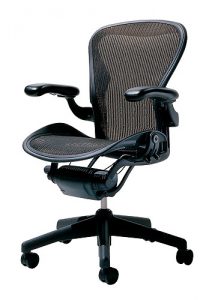 Herman Miller pieces that fit the criteria of good design is almost too exhaustive to list, but worth study for anyone interested in mid to late 20th century modernism. By the 21st century the firm displayed it’s further relevance and social conscience by putting an emphasis on sustainability. This has been reflected by it’s self created Perfect Vision doctrine which strives for silver LEED certification in it’s new constructions along with 100 percent renewable electric generation, zero landfill, zero hazardous waste and zero air emissions by the year 2020. In 2014 the company acquired Design Within Reach as part of an effort to make their offerings more accessible to a wider range of consumers. The combined commitments to both design aesthetics and sustainability have assured Herman Miller a place on the most admired companies list repeatedly over the past few decades and keep them well positioned to continue in this tradition well into the 21st century.
Herman Miller pieces that fit the criteria of good design is almost too exhaustive to list, but worth study for anyone interested in mid to late 20th century modernism. By the 21st century the firm displayed it’s further relevance and social conscience by putting an emphasis on sustainability. This has been reflected by it’s self created Perfect Vision doctrine which strives for silver LEED certification in it’s new constructions along with 100 percent renewable electric generation, zero landfill, zero hazardous waste and zero air emissions by the year 2020. In 2014 the company acquired Design Within Reach as part of an effort to make their offerings more accessible to a wider range of consumers. The combined commitments to both design aesthetics and sustainability have assured Herman Miller a place on the most admired companies list repeatedly over the past few decades and keep them well positioned to continue in this tradition well into the 21st century.
Steelcase, the largest of the five mentioned companies, was founded in 1912 in Grand Rapids, MI, making steel cases (safes). Initially called The Metal Office Furniture Company from their very beginnings they were innovators in sheet metal fabrication and produced lines of metal filing cabinets. In 1914 the company started manufacturing the steel Vector wastebasket which soon proved to be the firms first breakthrough 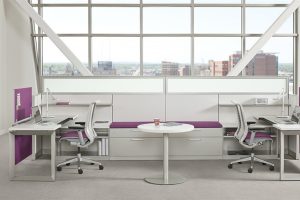 product largely for safety reasons in a era when the combination of indoor smoking and wooden wastebaskets could often prove fatal. By 1915 the company introduced a line if metal desks and was soon producing an entire line of metal office furniture under the guise of being fireproof. By the mid 1930s they tapped the skills of Frank Loyld Wright to produce the very first office workstation. By the late 1940s they introduced standardized desk sizes and by 1953 began offering their furniture in numerous colors in addition to the standard gray which had become the default color at the time. They changed their name to Steelcase in 1954 and by 1974 became the largest manufacturer of office furniture in the world a title they hold unto this day. By virtue of being majority stakeholder, Steelcase is directly associated with IDEO based in Evanston (Chicago) and in recent years and has had occasion to work with the Design Engine training arm in the area of customized Creo/ProE 3D classes. In 1989 the firm invested over 111 million in a pyramid shaped building built in Grand rapid which it called the Steelcase Corporate Development Center. This notable building was vacated by Steelcase in 2010 and subsequently sold for a tiny fraction of it’s building cost in 2014. This reflects the belief that they may have overbuilt and overextended in the late 20th century and have only in the 21st century become more lean and profitable. Their Leap chair remains iconic and is still seen as the best of turn of the century office seating being both aesthetic and ergonomic.
product largely for safety reasons in a era when the combination of indoor smoking and wooden wastebaskets could often prove fatal. By 1915 the company introduced a line if metal desks and was soon producing an entire line of metal office furniture under the guise of being fireproof. By the mid 1930s they tapped the skills of Frank Loyld Wright to produce the very first office workstation. By the late 1940s they introduced standardized desk sizes and by 1953 began offering their furniture in numerous colors in addition to the standard gray which had become the default color at the time. They changed their name to Steelcase in 1954 and by 1974 became the largest manufacturer of office furniture in the world a title they hold unto this day. By virtue of being majority stakeholder, Steelcase is directly associated with IDEO based in Evanston (Chicago) and in recent years and has had occasion to work with the Design Engine training arm in the area of customized Creo/ProE 3D classes. In 1989 the firm invested over 111 million in a pyramid shaped building built in Grand rapid which it called the Steelcase Corporate Development Center. This notable building was vacated by Steelcase in 2010 and subsequently sold for a tiny fraction of it’s building cost in 2014. This reflects the belief that they may have overbuilt and overextended in the late 20th century and have only in the 21st century become more lean and profitable. Their Leap chair remains iconic and is still seen as the best of turn of the century office seating being both aesthetic and ergonomic.
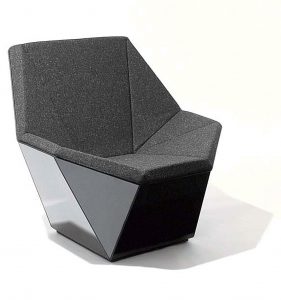
Knoll, although based in the Greenville, PA area north of Philadelphia, has a significant presence in Grand Rapids, MI. Founded in 1938 the company, like Herman Miller has had significant presence in not only the office space but in contemporary home furnishings and they have to their name numerous modern classics having also worked with what can be described as a who’s who of notable 20th century industrial designers. Design Engine worked with 3D drawings in Pro/E in the first decade of the 20th century at the Greenville location focusing primarily of office chair mechanisms. They remain a leader in ergonomic 21st century office chair design and are still at the vanguard of modernism for both home and office decor.
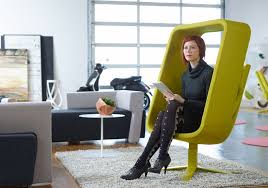
Haworth located in Holland, MI was founded in 1948 and remains to this day a privately held company. Having exceeded the billion a year in sales by the mid 90s the company ranks third among office furniture after Steelcase and Herman Miller. Often going head to head with the likes of Steelcase over the past few decades they have innovated in the area of modular and mobile office furniture in addition to seating. In the past few years they have purchased the noted Italian firm Poltrona Frau and have acquired majority stakes in other Italian modern furniture firms such as Alias, Cassina and Cappellini making them a powerhouse in the modern home decor space in addition to office solutions. Haworth’s Paperclip Stool of a generation ago and more recent Window Seat are two high points among it’s many impressive, standout designs over the past several decades. Design Engine has had Haworth office seating at it’s Chicago office but has no formalized relationship with Haworth.
HNI Corporation has under it’s umbrella both Hon and All Steel. The only one of the aforementioned firms not located in Western Michigan its headquarters are in Muscatine Iowa. Founded as HON in 1944 the firm is today the second largest global office furniture manufacturer. Initially called HON (short for Home-O-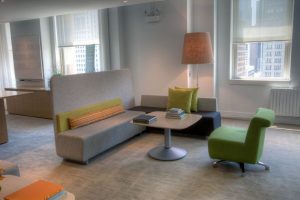 Nize company) the company at first keyed in on cabinetry and kitchen decor items including recipe file boxes which in turn led it into the office furniture space. Design Engine has had a steady relationship with people from the All Steel division providing Pro/E (PTC Creo) related courses for the designers and engineering staff over the past decade.
Nize company) the company at first keyed in on cabinetry and kitchen decor items including recipe file boxes which in turn led it into the office furniture space. Design Engine has had a steady relationship with people from the All Steel division providing Pro/E (PTC Creo) related courses for the designers and engineering staff over the past decade.
Each of these firms has ushered forth creativity, forward thinking and a keen sense of design aesthetic to the world as a whole and we are proud to have worked with their design and engineering staffs over the years. We feel optimistic that all five of these firms will remain integral to the field of modern furniture field and will continue to lead in both design and innovation as the 21st century progresses.
Article written by Dave Mazovick for Design Engine, April 14th 2016.

